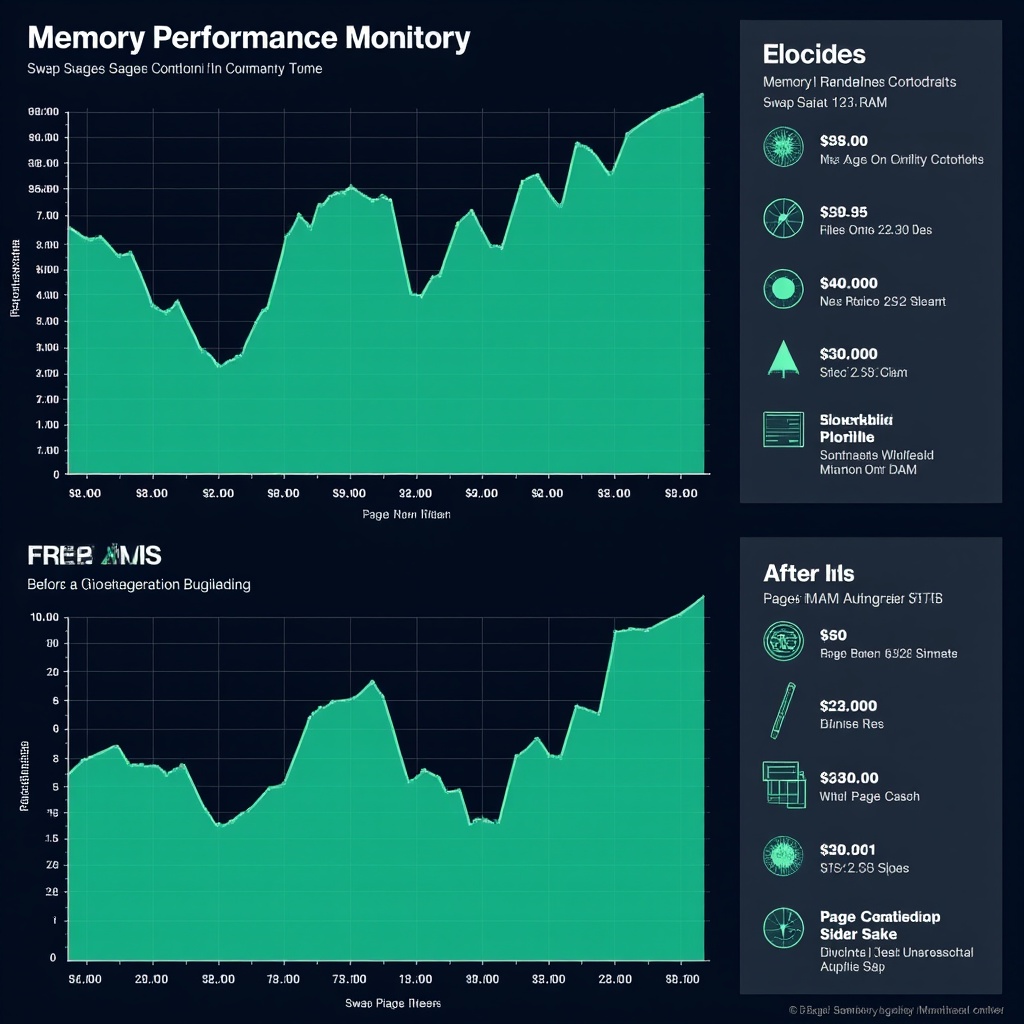-
How to Improve Linux System Performance: A Comprehensive Technical Guide

Linux system performance optimization is a systematic process that transforms sluggish systems into highly efficient machines. Whether you're managing database servers, web applications, or development workstations, understanding how to identify bottlenecks and apply targeted optimizations can dramatically improve throughput, reduce latency, and maximize resource utilization. This comprehensive guide covers the complete optimization lifecycle from measurement through implementation to persistent configuration management.
Understanding Linux Performance Optimization
Performance optimization in Linux operates across multiple layers of the system architecture. The Linux kernel controls resource allocation and scheduling, managing how CPU cycles, memory pages, disk I/O operations, and network packets are distributed among processes. Understanding these layers helps you target optimizations effectively.
Linux performance optimization encompasses several categories: hardware resource management, kernel-level tuning, filesystem optimization, and application-level configuration. Each category offers different optimization opportunities with varying impacts. Realistic performance improvements typically range from 10-50% for targeted optimizations, with compound effects possible when multiple subsystems are tuned coherently. The key is systematic, evidence-based optimization rather than applying random tuning parameters without understanding their effects.
Establishing Performance Baselines and Benchmarking
Before implementing any optimization, establishing baseline performance metrics is critical. Without measurable baselines, you cannot validate whether your optimizations actually improve performance or inadvertently degrade it. This foundational step separates effective optimization from cargo-cult tuning.
Key benchmarking tools provide quantifiable performance data across different subsystems. Sysbench tests CPU performance and memory throughput, fio (Flexible I/O Tester) measures disk I/O characteristics including sequential and random read/write operations, and iperf3 evaluates network bandwidth and latency. Each tool generates specific metrics that serve as your optimization baseline.
To establish a CPU baseline using sysbench:
sysbench cpu --cpu-max-prime=20000 --threads=4 runFor disk I/O baseline measurement with fio:
fio --name=randread --ioengine=libaio --iodepth=16 --rw=randread --bs=4k --direct=1 --size=1G --runtime=60 --filename=/dev/sdaDocument all baseline metrics systematically, including timestamp, kernel version, hardware configuration, and workload conditions. This documentation enables valid before-after comparisons and helps identify which optimizations deliver measurable improvements. Re-benchmark after each significant optimization change to track progress and detect regressions.
Identifying Performance Bottlenecks
Systematic bottleneck identification directs optimization efforts toward areas with highest impact. Linux provides comprehensive monitoring tools that reveal resource contention, saturation points, and performance constraints across all major subsystems.
The top and htop utilities provide real-time process monitoring, revealing CPU utilization patterns, memory consumption, and load averages. Load average values indicate system demand: values consistently above the number of CPU cores suggest CPU saturation. The 'wa' (wait) percentage in CPU stats indicates I/O bottlenecks—high wait percentages mean processes spend significant time waiting for disk operations.
The vmstat command provides crucial memory and swap statistics:
vmstat 1 10This displays statistics at 1-second intervals for 10 iterations. Watch the 'si' (swap in) and 'so' (swap out) columns—non-zero values indicate memory pressure forcing swap usage, which dramatically degrades performance. The 'free' column shows available memory, while 'buff' and 'cache' show buffer and page cache usage.
For disk I/O analysis, iostat reveals device-level performance:
iostat -x 5The extended statistics show %util (device utilization), await (average wait time), and r/s and w/s (reads and writes per second). Utilization consistently above 80% indicates I/O saturation, while high await values reveal latency issues.
The sar (System Activity Reporter) tool captures historical performance data, enabling trend analysis and bottleneck correlation over time. These monitoring tools work together to provide comprehensive visibility into system behavior and resource contention patterns.
Optimizing Memory and RAM Usage
Memory optimization directly impacts overall system performance because memory pressure triggers expensive swap operations that can reduce throughput by orders of magnitude. Linux memory management includes several tunable parameters that control swap behavior, cache utilization, and page management.
Swappiness Configuration
The vm.swappiness kernel parameter controls the kernel's tendency to swap memory pages to disk. The default value of 60 means the kernel fairly aggressively moves pages to swap. For systems with adequate RAM, especially servers, reducing swappiness minimizes disk thrashing:
sysctl vm.swappiness=10This setting tells the kernel to avoid swapping unless memory pressure becomes severe. For desktop systems with limited RAM, values between 10-30 balance responsiveness against swap usage. Database servers often benefit from even lower values (1-10) to keep working sets in physical memory.
Dirty Page Ratios
Linux caches modified (dirty) pages in memory before writing them to disk. Two parameters control this behavior:
sysctl vm.dirty_ratio=10
sysctl vm.dirty_background_ratio=5The vm.dirty_ratio (default 20) sets the maximum percentage of memory that can contain dirty pages before processes are blocked to flush data. Lowering this value reduces the risk of sudden I/O storms. The vm.dirty_background_ratio (default 10) triggers background flushing. Lower values create more consistent I/O patterns at the cost of slightly higher overhead.
Transparent Huge Pages
Transparent Huge Pages (THP) can improve performance for applications with large memory footprints by reducing TLB (Translation Lookaside Buffer) pressure. However, some database systems experience latency spikes with THP enabled. Check THP status and disable if needed:
cat /sys/kernel/mm/transparent_hugepage/enabled
echo never > /sys/kernel/mm/transparent_hugepage/enabled
Optimizing Disk I/O Performance
Disk I/O optimization addresses one of the most common performance bottlenecks in Linux systems. The I/O scheduler, read-ahead buffers, and block device parameters significantly impact storage performance.
I/O Scheduler Selection
Linux offers multiple I/O schedulers, each optimized for different storage technologies and workload patterns. Modern systems use multi-queue schedulers for improved parallelism:
- mq-deadline: Best for most SSD workloads, provides latency guarantees while maximizing throughput
- kyber: Optimized for fast multi-queue devices, excellent for NVMe SSDs
- bfq (Budget Fair Queueing): Ideal for interactive systems and rotational drives
- none: Bypasses scheduling for ultra-low latency NVMe devices
Change the I/O scheduler for a specific device:
echo mq-deadline > /sys/block/sda/queue/schedulerFor NVMe SSDs handling random I/O workloads, the 'none' scheduler often delivers optimal performance by eliminating scheduling overhead. Rotational hard drives benefit from schedulers that minimize seeking, like bfq or mq-deadline.
Read-Ahead Tuning
Read-ahead pre-fetches sequential data from storage into memory. Optimal read-ahead values depend on workload characteristics—sequential workloads benefit from larger read-ahead, while random access patterns may see reduced performance:
blockdev --setra 256 /dev/sdaThis sets read-ahead to 256 512-byte sectors (128 KB). Database servers with random access patterns often benefit from lower values (128-512), while sequential workloads like video streaming may use higher values (2048-8192).
Filesystem Mount Options
Mount options significantly affect filesystem performance. The noatime option eliminates access time updates, reducing write operations:
mount -o noatime,nodiratime /dev/sda1 /mntFor ext4 filesystems, consider the data=writeback mode for maximum performance, though this trades some crash recovery guarantees for speed. Always test in non-production environments first.
Kernel Parameter Tuning
The Linux kernel exposes thousands of tunable parameters through the sysctl interface, controlling everything from process scheduling to network behavior. Understanding key parameters enables fine-grained performance optimization.
The
/proc/syshierarchy organizes kernel parameters by subsystem. The sysctl command modifies parameters at runtime:sysctl -a | grep vmThis displays all virtual memory parameters. Critical parameters for performance include:
- kernel.sched_migration_cost_ns: Controls CPU scheduling migration costs (default 500000)
- fs.file-max: Maximum number of file handles (increase for high-connection servers)
- kernel.pid_max: Maximum number of processes (default 32768)
Increase file descriptor limits for high-concurrency applications:
sysctl fs.file-max=2097152Kernel parameters interact in complex ways—changing one parameter may affect others. Always modify parameters incrementally and measure impact before applying additional changes.
Optimizing CPU Performance
CPU optimization focuses on frequency scaling, process scheduling, and core affinity. Modern processors adjust frequency dynamically based on workload, but aggressive power management can reduce performance.
CPU Governor Configuration
The cpufreq subsystem provides CPU governors that control frequency scaling behavior:
- performance: Runs CPU at maximum frequency constantly
- ondemand: Dynamically adjusts frequency based on load
- powersave: Minimizes frequency for power savings
- schedutil: Modern scheduler-driven frequency scaling
For maximum throughput, set the performance governor:
cpupower frequency-set -g performanceThis eliminates frequency scaling delays but increases power consumption. Production servers handling latency-sensitive workloads typically use the performance governor.
CPU Affinity and Process Priority
Binding critical processes to specific CPU cores reduces cache thrashing and improves performance predictability:
taskset -c 0,1 myprocessThis binds 'myprocess' to cores 0 and 1. CPU affinity works particularly well for real-time applications and high-throughput network services.
Network Performance Tuning
Network optimization is crucial for servers handling high connection rates or bulk data transfer. TCP buffer sizing and congestion control algorithms directly impact network throughput.
Socket Buffer Configuration
Increase socket buffer sizes for high-bandwidth networks:
sysctl net.core.rmem_max=134217728
sysctl net.core.wmem_max=134217728
sysctl net.ipv4.tcp_rmem='4096 87380 134217728'
sysctl net.ipv4.tcp_wmem='4096 65536 134217728'These settings allow TCP to use up to 128 MB buffers, essential for high-bandwidth-delay product networks. Default values limit throughput on fast networks with any latency.
TCP Congestion Control
Modern congestion control algorithms like BBR (Bottleneck Bandwidth and RTT) improve throughput in many scenarios:
sysctl net.ipv4.tcp_congestion_control=bbrBBR often outperforms traditional algorithms like CUBIC on networks with packet loss or variable latency.
Managing System Services and Processes
Unnecessary system services consume CPU, memory, and I/O resources. Identifying and disabling unused services frees resources for critical workloads.
List all enabled services:
systemctl list-unit-files --state=enabledAnalyze which services consume resources:
systemd-analyze blameCommon services safe to disable on servers include bluetooth, cups (printing), avahi-daemon (network discovery), and ModemManager. Always verify service dependencies before disabling:
systemctl disable bluetooth.serviceMaking Optimizations Persistent
Runtime optimizations using sysctl commands don't survive reboots. Making changes persistent requires configuration file modifications.
Kernel Parameter Persistence
Add kernel parameters to
/etc/sysctl.confor create files in/etc/sysctl.d/:echo 'vm.swappiness=10' >> /etc/sysctl.conf
echo 'vm.dirty_ratio=10' >> /etc/sysctl.confApply changes immediately and verify persistence:
sysctl -pUsing
/etc/sysctl.d/enables modular configuration management—create separate files for different optimization categories (memory.conf, network.conf, disk.conf).Systemd Unit Configuration
For optimizations requiring commands at boot (like I/O scheduler changes), create systemd service units. This ensures optimizations apply automatically across reboots and survive system updates.
Test persistent configuration after reboot to verify all settings apply correctly. Document all changes with comments explaining the rationale and expected impact.
Using Automated Tuning Tools
The TuneD daemon provides automated, profile-based optimization for common workload types. TuneD applies collections of optimizations dynamically based on system activity.
List available tuning profiles:
tuned-adm listCommon profiles include throughput-performance (maximizes throughput), latency-performance (minimizes latency), network-latency, and virtual-guest. Activate a profile:
tuned-adm profile throughput-performanceTuneD provides quick, safe optimization for typical workloads but lacks the granularity of manual tuning. For specialized requirements, manual optimization delivers better results.
Workload-Specific Optimization Strategies
Different workload types require different optimization priorities. Database servers prioritize I/O performance and memory management, web servers focus on network throughput and connection handling, and development workstations optimize for interactive responsiveness.
Database Server Optimization: Emphasize I/O scheduler tuning (mq-deadline or none), aggressive read-ahead reduction, low swappiness (1-5), huge page enablement, and filesystem optimization (noatime, appropriate journal modes).
Web Server Optimization: Focus on network buffer sizing, TCP congestion control (BBR), connection table limits, file descriptor maximization, and CPU governor settings for consistent latency.
Virtualization Host Optimization: Tune CPU scheduling parameters (sched_migration_cost_ns), memory overcommit settings, huge page allocation, and I/O scheduler selection for underlying storage.
Development Workstation Optimization: Balance responsiveness and power efficiency—use ondemand or schedutil CPU governor, moderate swappiness (30-60), and I/O scheduler optimization for SSD responsiveness.
Testing and Validating Optimizations
Never apply optimizations directly to production systems. Establish testing environments that mirror production characteristics, apply changes incrementally, measure impact through benchmarking, and document results comprehensively.
Create configuration backups before optimization:
cp /etc/sysctl.conf /etc/sysctl.conf.backupImplement changes one subsystem at a time, benchmark after each change, and allow time for performance characteristics to stabilize. Some optimizations show immediate impact while others require sustained workload exposure to reveal benefits or problems.
Monitor systems continuously after optimization deployment. Performance regressions sometimes emerge under specific workload conditions not represented in testing. Maintain rollback procedures for rapid recovery if optimizations cause unexpected issues.
Linux system performance optimization is a systematic, evidence-based practice. Start with baseline measurement, identify actual bottlenecks through monitoring, apply targeted optimizations incrementally, validate effectiveness through benchmarking, and persist successful configurations properly. This methodology delivers measurable, sustainable performance improvements while maintaining system stability and avoiding counterproductive cargo-cult tuning. Remember that optimization is iterative—systems evolve, workloads change, and periodic re-evaluation ensures optimizations remain effective and relevant.